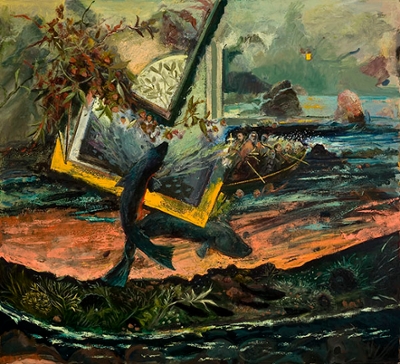Robert Barnes has been called the "most famous unknown painter in America." The goal of the Indiana University Art Museum's special exhibition Grand Allusions: Robert Barnes—Late Works 1985-2015, on view September 26-December 20, 2015, is to bring greater attention and new scholarship to the work of this fascinating abstract/figural artist. Picking up where his 1985 mid-career retrospective, organized by the Madison [Wisconsin] Art Center, left off, the exhibition surveys Barnes's work from the past thirty years. Often identified as a Chicago School artists because of his training at the School of the Art Institute of Chicago and his representation by several major Chicago area galleries, his style defies simple categorization. His work is representational, but it lacks the cartoon-like sensibility of the Chicago School artists included as members of the Hairy Who, Monster Roster, or Chicago Imagists. It combines a New Figurative painterly aesthetic with the playfulness and psychological complexity of a Surrealist collage.
After his retirement from thirty-five years of teaching in Indiana University's Henry Radford Hope School of Fine Arts, Barnes and his wife Nancy moved from Bloomington to Seaport, Maine. Living along the Maine coast in a centuries-old fishing village offered new inspiration. The art, culture, and people of the mountains of Umbria, Italy, where Barnes has a second home, also continue to be catalysts for his creativity.
Barnes's work remains rooted in his personal heritage and in a long narrative art tradition from the Italian Renaissance and Romanticism to the illustrations of N.C. Wyeth and Walt Disney. The exhibition strives to unravel the rich thematic allusions in the artist's oeuvre, while at the same time allowing the viewer to relish his painterly virtuosity. In addition to eighteen large-scale paintings from his major series, including The Sources of Power, Silkies, Blood and Perfume, The Ogham, Jettatura, and Paradise, there are twenty examples of his works on paper, which Barnes considers a continuation of his ideas in yet another painting medium.
The exhibition is accompanied by a fully-illustrated catalogue and was made possible with support from Patrick Duffy in honor of Wally Goodman, the Doris Steinmetz Kellett Endowed Fund for the Twentieth-Century Art Collection, the Henry and Gilda Buchbinder Family, the Morrow Family Foundation, Susan Thrasher, David H. Jacobs, Bill and Kay Carmichael, Joe and Sandy Morrow, Retired Faculty Grant-in-Aid from Indiana University's Office of the Vice Provost for Research, Paul Caccia and Carmela Zammuto, Kenneth and Patricia Northcott, Linda Alterwitz, Frank and Robin Schneider, and the IU Art Museum's Arc Fund.
The exhibition catalogue is available for purchase through IU Press and at the IU Art Museum's Café and Gift Shop.



